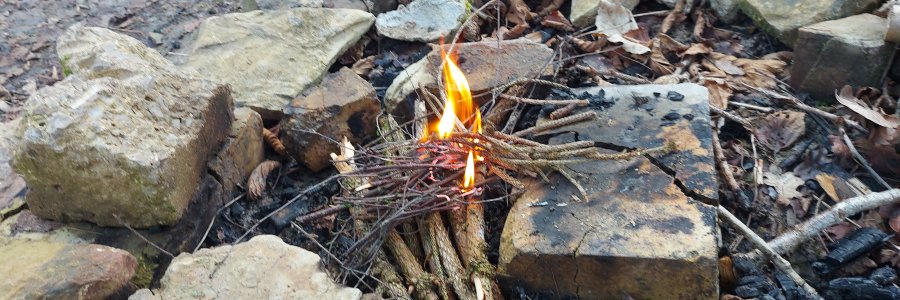Bushcraft is not JUST about fires. There is plenty of appreciation around a campfire, and joy in establishing a first fire.
But how about why we're striking a ferrorod, or creating a tinder bundle, and what's going on?
Our outdoor teaching provides the understanding of basic principals and components, such as appropriate resources and how to find them. By teaching the background, our course participants are more confident in what they are they doing towards the end result, and progressing further - not just making a fire, but using it fully.
Principals
We all vaguely remember the "fire triangle" components from school science lessons - every fire needing fuel, oxygen and heat in order to burn - but in a woodland environment, it is important to consider how each of these elements can be disrupted. Fuel may be damp, and therefore cold; we may need to provide more oxygen (airflow) depending on how the fire is constructed; the ground may be cold and damp, and so our fire needs lifting off it.
The extension from school science continues as we consider different sources of heat, and the way to find and harness those sources for ignition:
- solar
- electrical
- chemical
- friction
- compression
- percussion
On our Trex Explore courses, we teach the use of various tools and techniques which create sources of ignition, to enable progression of a simple campfire. In readiness for a true off-grid situation (adventure excursion, woodland camp, or necessary survival), it is essential to know a few different approaches, to have the tools, and be practiced in using them.

Natural Fuel Sourcing
We begin most of our courses with introduction to the trees around us, to increase participants awareness and engagement in the local natural environment, but also to provide understanding of the variation in the utility of the wood and bark. The properties of different trees form ancient knowledge, which we can use to our benefit when progressively building a campfire.
For example: wispy birch bark will catch a spark and smoulder well and also contains natural oils which helps extend and accelerate flames; ash wood will burn well even when freshly cut (with initial heat prepared); and pine-family trees can provide resin which extends our flames.
Understanding the characteristics and behaviour of natural materials, is best achieved with practical learning - we discuss the material, as above, demonstrate, then encourage and guide you to explore for yourself!
Responsible Fire Use
Having spent time collecting and preparing materials, creating an ember, then building and maintaining a campfire, there is a lot of sense in making that fire as useful as possible. Whilst delivering courses, we at Trex have found that same realisation re-occuring amongst our participants - we've put a lot of effort in, so what else can we utilise that for? This theme is echoed in awareness of minimising our use of natural resources, for longevity of everyone on the planet; there are subsequent effects of burning wood, of any kind - we're releasing carbon into the atmosphere and having potentially stopped a tree's growth and wildlife habitat.
Therefore, we should aim for our campfire to have multiple uses where possible - not just for pleasant visual effect.
Further uses include:
- food preparation (with a grill, pot, or cooking in the embers)
- charcoal / charcloth making
- water heating (for drinks/washing)
- water boiling (for purification)
- tool making (such as for hollowing out a spoon)
Conclusions
We enjoy teaching firecraft!
There is always a wonderful moment of satisfaction for anyone who successfully ignites some loose tinder, and even progresses to a fire.
Whilst learning the practical elements, our aim and hope is that each participant is building a deeper understanding and awareness of outdoor off-grid living, and a better appreciation of the resources around us. The underlying scientific principals might not have been known by our ancient ancestors, yet they held and respected the knowledge of their environment.
We teach you what to look for and how to us it - you take those fundamental skills onwards!
Further Reading
- https://www.livescience.com/chemistry/why-does-striking-flint-against-steel-start-a-fire
- https://terrafirma.ac.uk/fires-net-impact-on-the-global-carbon-cycle/
- https://fairclimatefund.nl/en/cooking-on-open-fire/

